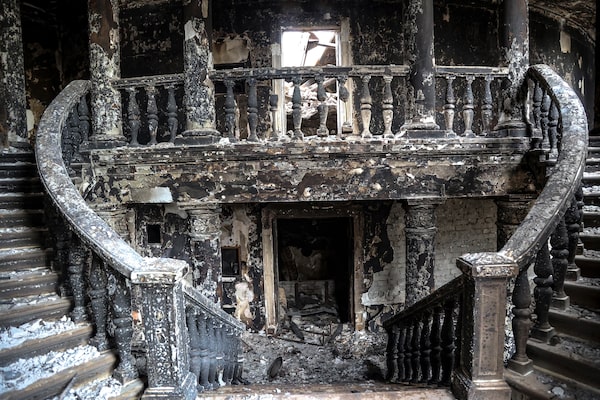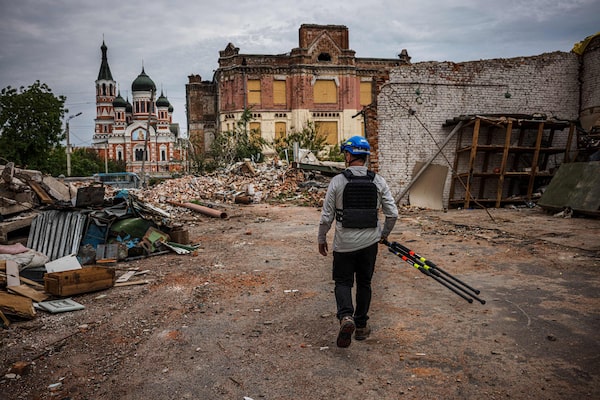In a village near Kharkiv, employees of the Hryhoriy Skovoroda Literary Memorial Museum remove the statue of its namesake, an 18th-century philosopher, this past May after Russian shelling hit the building.Ricardo Moraes/Reuters
The statue of Hryhoriy Skovoroda stared upward from the ruins of the museum. On the night of May 6, an institution dedicated to the work of the late Ukrainian poet had been hit by a Russian shell, local officials said. The walls and roof were reduced to rubble.
Would Russia deliberately target this small institution near Kharkiv? Many Ukrainians believed they had, and saw the attack as part of a systematic effort to destroy Ukraine’s identity. Ukrainian President Volodymyr Zelensky cited the incident in a speech a few days later. The Russians, he said, “believe their missiles can destroy our philosophy.”
In the Ukraine-Russia conflict, cultural sites have become a front of their own. With its offensive, Russia is challenging the very existence of a Ukrainian culture and nation. But even before the conflict, Ukrainians were debating how to think of their own history and of buildings from the Soviet era. Today, some of Ukraine’s historic places face immediate threats and an uncertain future.
In late June, a report from the United Nations cultural agency UNESCO found that Russian forces had damaged or destroyed more than 150 sites of cultural significance. The largest numbers of these are in Donetsk, Kharkiv and Kiev. “These repeated attacks on Ukrainian cultural sites must stop. Cultural heritage, in all its forms, should not be targeted under any circumstances,” said UNESCO director-general Audrey Azoulay in a statement.
Buildings and other historic places matter deeply in this conflict, says Ievgeniia Gubkina, the editor of the online Encyclopedia of Ukrainian Architecture. “When we see the consequences of the attacks – of phosphoric bombs, for example, on people’s lives – in that moment, we could ask, who cares about buildings?” she said. “Well, in such moments, morale is important, and heritage becomes most critical.”

Debris inside the Donetsk Academic Regional Drama Theatre in Mariupol on April 4.Alexei Alexandrov/The Associated Press
Ms. Gubkina, a Ukrainian architect and historian raised in Kharkiv, is currently in exile in Paris. She noted a clear pattern of Russian forces deliberately targeting places of cultural significance. The most infamous example is the bombing of a theatre in Mariupol in March, which killed an estimated 600 people.
She suggests that Russian forces have deliberately avoided targeting churches. Russian President Vladimir Putin is closely allied with the Russian Orthodox Church, with which many Ukrainian churches are affiliated.
But Ms. Gubkina is worried for the buildings that are her specialty: those from the Soviet period, which spanned 1922 to 1991. She cited the 1920s Derzhprom complex of towers in central Kharkiv, which is associated with the Constructivist movement, an early and radical stream of modernism in architecture.
“It is our masterpiece,” Ms. Gubkina said of the complex, which was built to house the new government of Soviet Ukraine.
And yet, she points out that UNESCO, the cultural arm of the United Nations, has not yet added Derzhprom to its World Heritage List. Ms. Gubkina argues that the site should be recognized by UNESCO, which would lend it some degree of protection, since destroying it would then amount to a war crime under international law.

The Derzhprom complex in Kharkiv, circa 1935, was finished in 1928. Its name is a shortening of the Russian words for 'state' and 'industry.'Fox Photos/Hulton Archive/Getty Images
:format(jpeg)/cloudfront-us-east-1.images.arcpublishing.com/tgam/R26O32JN5FI2DAX4EPEUZYLU6E.JPG)
:format(jpeg)/cloudfront-us-east-1.images.arcpublishing.com/tgam/XMBJY2HOX5HJZCOAXFUF2JE5VA.JPG)
Meanwhile, Russian forces have targeted hundreds of lesser-known sites which, she argues, have their own cultural value. This include panelka, Soviet-era apartment towers made with prefab concrete panels that house large numbers of Ukrainians. Many have been damaged or destroyed by Russian strikes – including in southern Kharkiv, where Ms. Gubkina grew up. This pattern of deliberately targeting residential neighbourhoods, she says, destroys places that have shaped the social life of the country.
“Sometimes heritage is just about where you lived, where you kissed a girl for the first time,” she said.
Her remarks capture a tension in the world of heritage preservation. Increasingly, places associated with ordinary citizens – not just the homes and workplaces of the elite – are seen by professionals as worthy of commemoration. And yet Ukraine’s uneasy relationship with its 20th-century history adds a layer of ambiguity. Mass housing such as panelka “are difficult and strange [as] heritage,” Ms. Gubkina said. “Grey concrete can look ugly to people … it’s not like a nice old house that people think of when you say ‘heritage.’”
Indeed, panelka and other Soviet-era buildings have been subjects of controversy within Ukraine. The national government, after the 2014 revolution, passed “decommunization” laws that called for the removal of Soviet monuments and art. For Ms. Gubkina, those rules have been applied – or misapplied – to destroy public art and architecture from the Soviet era. That period, which forms a major part of Ukraine’s history, has been the subject of scholarly and political debate over the past decade. Ms. Gubkina is part of a cadre of young Ukrainian scholars and activists who see that period as worthy of commemoration.
Another is Dmytro Soloviov, an activist and photographer who has run the Instagram account Ukrainian Modernism since 2017. Since the conflict began, he has documented the destruction of airports and train stations, university buildings and cultural complexes, all of the Soviet era.
But he says his defence of such buildings is not welcomed by all Ukrainians. “There are some bad memories from the Soviet period, and there is an anti-Russian rhetoric being pushed by some Ukrainians,” he said. “I have heard people call Putin communist, which is ridiculous. But people who are under constant shelling don’t have time for nuances.”
As The Globe’s Mark MacKinnon reported recently, anti-Russian sentiment is now being directed to statues and street names associated with pre-Soviet Russia, and even in the relatively pro-Russian eastern part of Ukraine. In the west, Mr. Soloviov says, the anti-Russian sentiment is much stronger.
That leaves some sites in danger both from Russian attack and from internal nationalism.
Which raises difficult questions for Ukraine’s future. When the conflict is over, what ideas will shape the rebuilding process? Will that effort work to wipe out the past?
“There is a sentiment towards completely rebuilding damaged areas or buildings instead of renovation,” Mr. Soloviov said. “Officials often want to build something new, instead of renovating and preserving the urban landscape.”
In a sense, Ms. Gubkina suggests, this would complete the Russian intent to damage the very idea of a Ukrainian culture.
“This war is an imperial war,” says. “But not the way we think about that word in the West. Russians don’t need our resources; they don’t need our people. They don’t need new colonies. They need us to be demolished.”

French engineer Emmanuel Durand uses his laser-scanner on May 26 to map the architecture of the Kharkiv fire station, which was built in 1887.DIMITAR DILKOFF/AFP via Getty Images
Ukrainian landmarks caught in the crossfire
Ukraine has seven World Heritage Sites designated by UNESCO; none of these have, yet, been badly damaged. However, hundreds of other sites of cultural significance have been damaged or destroyed.
Mariupol train station
Mariupol, a strategic port city and rising cultural capital, was devastated by Russian bombardment before the city fell in May. Along with the destruction of its Drama Theatre, the city also lost its train station. The station was largely destroyed by a fire, which consumed at least one of the Soviet-era decorative mosaics within.
Admiral Makarov National University
This university in the southern city of Mykolaiv trains engineers in shipbuilding. While obscure, its 1971 facility was, according to Dmytro Soloviov, “one of the finest gems of brutalist architecture” in that city. It was badly damaged by Russian strikes in July.
Palace of Culture in Lyman
Russian forces have targeted several “palaces of culture,” which are cultural and community centres serving individual towns. This one in the Donetsk region, originally built in 1929, was destroyed in May.
Derzhprom
This Constructivist complex on Kharkiv’s central square was built in 1928 as the government headquarters for Soviet Ukraine. Its three clusters of towers, as tall as ten storeys, are joined by bridges. The British critic Owen Hatherley called it “one of the most interesting and least known” modernist buildings of its era. It has not yet been targeted by Russian forces; however, Russian missiles and rockets hit the adjacent Freedom Square and a nearby local government office.
Panelkas
The Saltivka neighbourhood in suburban Kharkiv was the site of intense bombardment in the early days of the war. “This kind of mass housing is typical for many places in Ukraine,” says the historian and architect Ievgeniia Gubkina, “home to many thousands of ordinary people.”
War in Ukraine: More from The Globe and Mail
The Decibel
Ukraine is not happy with Canada after it granted a Montreal company an exemption to anti-Russian sanctions to return a turbine for the Nord Stream 1 pipeline. Globe parliamentary reporter Steven Chase explains the controversy. Subscribe for more episodes.
Dispatches from Ukraine
Soaring inflation in Ukraine deepens economic toll of Russia’s invasion
Ukrainian farmers still face harvest troubles ahead after a year of misery
Ukrainian civilians are being taken from their homes and interrogated by Russian soldiers for weeks
Canada abandoned Ukrainian embassy employees despite their likelihood of being on Russian hit list